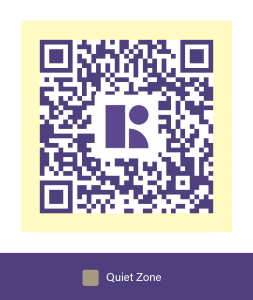QR codes (Quick Response codes) have become an increasingly popular way to share information, experiences and content from online spaces. In our previous blog posts, we’ve explained how to generate QR codes with Klu and now you can order a pack of pre-generated Klues from our website. But, how do QR codes work? What is the Anatomy of a QR Code? To clarify, QR codes are two-dimensional barcodes that consist of a pattern of black and white squares arranged on a square grid. The squares can be in various sizes and patterns, but the basic structure of the code remains the same.
QR Code Anatomy
Quiet Zone
The quiet zone is a margin of empty space which surrounds the QR code. It helps to separate the QR code from its surroundings. As a result, this zone is important for QR codes printed on a busy or colourful background.

Positioning Detection Pattern
The four corners of a QR code contain special squares known as a positioning detection pattern. Above all, these pattern helps a scanner determine the orientation of the code and how to decode the information contained within it. Positioning markers are the three squares in the bottom left, top left, and top right corners of the QR code. As a result, these markers define the pattern as a QR code and enable the scanner to recognise the direction of the code. The Alignment marker is the smaller square in the bottom right corner of the code. They help correct distortions from curved or uneven surfaces and ensure efficient decoding of the QR code.

Format And Version Information
Format and Version information are data patterns located next to the positioning markers. These patterns contain data about the programming of the QR code and define the method used to encrypt data into the pattern. Version information determines the version of a QR code. Lastly, A QR code’s version can range from 1 to 40, any QR code built in version 6 and above requires additional alignment markers. As the version increases, the number of squares within the code increases. As a result, the QR code can store larger quantities of data.

Timing And Data Region
Between each of the positioning markers exists a single line of code known as the timing pattern. Alongside format and version information, the timing pattern helps the scanner determine the data’s configuration and size of the QR code. Lastly, the data region comprises the remaining area of the QR code. This region holds the information stored in the QR code. The data region can contain various data types, including text, URLs, and contact information, among others.

Conclusion
Overall, the anatomy of a QR code is fairly simple, consisting of a pattern of black and white squares arranged on a square grid, with special patterns found in the corners and alignment patterns located throughout the code (For A Comprehensive Explanation Of QR Codes, Checkout This Article). Understanding the basics of how a QR code is structured can help users to create and identify codes more effectively, making them a more useful tool for sharing.


